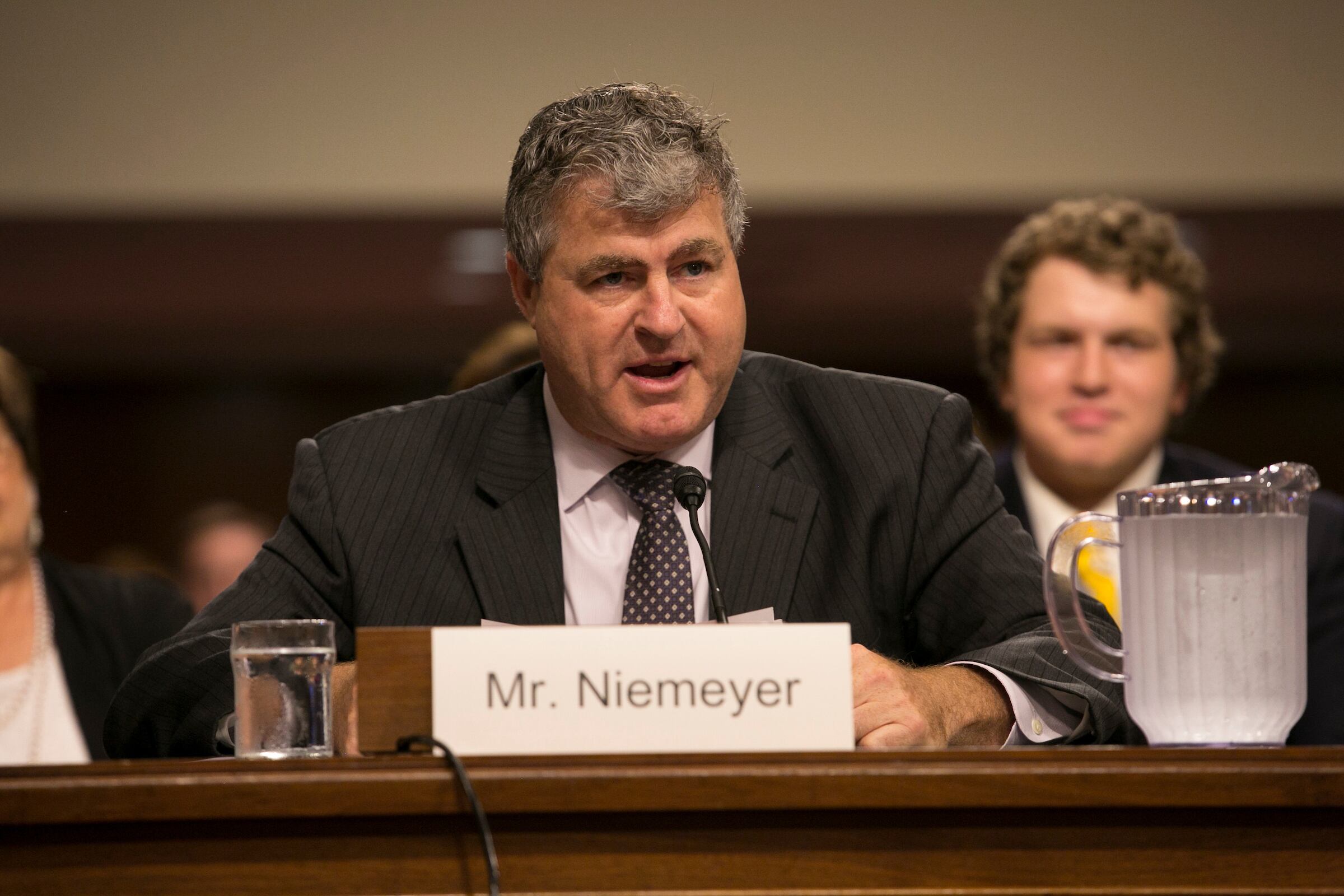Updated 3/9/20 at 12:35 PM EST to reflect the announcement of the contract awards
WASHINGTON — The Pentagon on Monday issued three contracts to start design work on mobile, small nuclear reactors, as part of a two-step plan towards achieving nuclear power for American forces at home and abroad.
The department awarded contracts to BWX Technologies, Inc. of Virginia, for $13.5 million; Westinghouse Government Services of Washington, D.C. for $11.9 million; and X-energy, LLC of Maryland, for $14.3 million, to begin a two-year engineering design competition for a small nuclear microreactor designed to potentially be forward deployed with forces outside the continental United States.
The combined $39.7 million in contracts are from “Project Pele,” a project run through the Strategic Capabilities Office (SCO), located within the department’s research and engineering side. The prototype is looking at a 1-5 megawatt (MWe) power range. The Department of Energy has been supporting the project at its Idaho National Laboratory.
Pele “involves the development of a safe, mobile and advanced nuclear microreactor to support a variety of Department of Defense missions such as generating power for remote operating bases,” said Lt. Col. Robert Carver, a department spokesman. “After a two-year design-maturation period, one of the companies funded to begin design work may be selected to build and demonstrate a prototype.”
“The Pele Program’s uniqueness lies in the reactor’s mobility and safety,” said Jeff Waksman, Project Pele program manager, in a department statement. “We will leverage our industry partners to develop a system that can be safely and rapidly moved by road, rail, sea or air and for quick set up and shut down, with a design which is inherently safe.”
However, Pele is not the only attempt at introducing small nuclear reactors to the Pentagon’s inventory.
A second effort is being run through the office of the undersecretary of acquisition and sustainment. That effort, ordered in the 2019 National Defense Authorization Act, involves a pilot program aiming to demonstrate the efficacy of a small nuclear reactor, in the 2-10 MWe range, with initial testing at a Department of Energy site in roughly the 2023 timeframe.
If the testing goes well, a commercially developed, Nuclear Regulatory Commission licensed reactor will be demonstrated on a “permanent domestic military installation by 2027,” according to DoD spokesman Lt. Col. Mike Andrews. “If the full demonstration proves to be a cost effective energy resilience alternative, NRC-licensed [reactors] will provide an additional option for generating power provided to DoD through power purchase agreements.”
The best way to differentiate between the programs may be to think of the A&S effort as the domestic program, built off commercial technology, as part of an effort to get off of local power grids that are seen as weak targets, either via physical or cyber espionage. Pele is focused on the prototyping a new design, with forward operations in mind — and may never actually produce a reactor, if the prototype work proves too difficult.
RELATED

According to an Oct. 2018 technical report by the Nuclear Energy Institute, 90 percent of military installations have “an average annual energy use that can be met by an installed capacity of nuclear power of 40 MWe or less.”
Replacing all local power with a nuclear reactor isn’t necessary for the department’s goals, but one or more reactors in the 2 to 10 MWe range, located on base, would ensure that if the local power grid goes down, critical functions will still be able to operate.
“The concern here is that, obviously, installations need energy, they need power,” Ellen Lord, the department’s acquisition head, explained last week at the annual McAleese conference. “Typically they are tied to the grid; what if the grid goes down, what if your generators don’t have fuel to work on for awhile? So, what we’re doing is looking at small nuclear modular reactors.”
Commercial availability
This isn’t the first time the DoD has looked into small nuclear reactors. The 2010 NDAA directed the department to study the feasibility of nuclear power for military installations, but a study concluded that the reactors available at the time were simply too big.
However, new developments in the commercial sector are opening up more options.
According to Dr. Jonathan Cobb, a spokesman for the World Nuclear Association, small nuclear reactors come in three flavors. The first, small modular reactors, sit in the 20-300 MWe range and are approaching the point they will appear on market.
The second category sits from 10-100 megawatts, and have been used in transports such as icebreakers. According to Cobb, a pair of 32 MWe reactors, based on icebreaker technology, are being used aboard the Akademik Lomonosov, a Russian “floating power plant.”
The third category, covering what the Pentagon appears most interested in, is a category known as microreactors. The challenge, Cobb said, is that this group is the furthest behind technologically, with demonstrations of commercial systems targeted for “the second half of the 2020s,” putting them in the “ballpark” of what DoD is looking for with its A&S effort.
According to the NEI study, the reduced size and increased simplicity of microreactors mean a procurement and manufacturing cycle could take “between 3 and 5 years from the order of long lead materials to the delivery of the largest component, with a nominal target of 4 years. Most of the components will need to arrive on-site at least 6 months prior to startup in order to support the achievement of construction milestones.”
“How they then would be developed to commercial applications may depend not only on industry developments, but also on establishing an effective regulatory environment. Most likely though we would be looking at microreactors coming into a commercial basis in the 2030s,” Cobb explained.
“While more recent large scale plants have made greater use of modular construction, for microreactors in particular we’d expect them to be produced as virtually finished factory-built units. There’s every possibility that as microreactors move towards commercialism the companies developing them may choose to collaborate with existing players in the nuclear industry.”
However, Edwin Lyman, director of the Nuclear Safety Project at the Union of Concerned Scientists, has concerns about the availability of fuel to power a proliferation of small nuclear reactors. He noted, "there are no clear plans for manufacturing the quantity of high-assay low enriched uranium, much less the production of high-quality TRISO [TRi-structural ISOtropic particle] fuel, that would be able to meet timelines this decade.”
American companies Westinghouse (0.2-5 MWe), NuScale (1-10 MWe), and UltraSafe Nuclear (5 MWe) are all developing reactors with less than 10 MWe output, while Sweden’s LeadCold (3-10 MW3) and a U.K. consortium led by Urenco (4 MWe) are also working on developing similar systems.
Lord, for her part, would not rule out working with foreign allies on the nuclear program in some way, saying “We always talk with our partners and allies about collaboration. We have many umbrella vehicles, if you will, to do that, particularly with [National Technology and Industrial Base] countries — U.K., Canada, Australia. We have a little bit of an easy button there for working back and forth with technical information.”
Safety concerns
As complicated as the A&S domestic effort may be, the idea of developing a mobile reactor for use abroad will likely be significantly more complex — and not just from a technological perspective.
Lyman believes that the department’s past efforts have “consistently underestimated”the “spectrum of mission risks posed by these microreactors," mostly around the technical challenges of keeping the radioactive fuel safe and operational in battlefield conditions.
“Fielding these reactors without commanders fully understanding the radiological consequences and developing robust response plans to cope with the aftermath could prove to be a disastrous miscalculation,” warned Lyman.
RELATED

Security would remain a major factor as well, with the risk of nuclear material from a reactor falling into the hands of terrorist groups needing to be accounted for. While the nuclear material likely to be used in these reactors is “highly impractical” for a pure nuclear weapon, Lyman warned that an enemy could still seek the material and use it in some form of dirty bomb scenario which could deny American forces access to a specific area; additionally, security protocols would need to be put in place to deal with the transfer of the reactors.
However, Marc Nichol, NEI’s Senior Director of New Reactors, believes the refueling process should be fairly simple, with the non-mobile reactors sought by A&S likely having a 10 year lifespan in between refueling needs and the mobile reactors brought back whole to the U.S. when they need a refresher.
“The idea is these would be refueled back in the United States at a centralized facility designed and equipped to do this work. No one is envisioning that these would be refueled in the field,” Nichol said. "Because they would be in a specialized facility here in the United States, there would be safety and security protocols in place for that. We have a lot of experience handling used fuel for our commercial reactors.”
Finally, there may be political challenges involved in deploying such systems. Some partner nations may balk at the idea of hosting a nuclear reactor, no matter how small. For instance, it is easy to picture the U.S. seeking to put a system for potential deployment, or as a power backup on a local base, in Japan, a key location for America’s force posture to counter China; such a move would likely be met with strong hostility, if not from politicians than from local protesters.
“I think most of these issues — including who would have regulatory authority and where liability would reside — have yet to be resolved,” said Lyman." And even if the legal pathway were clear, there could be significant public opposition in certain host countries to deployment of these reactors if solely under U.S. authority."
Costs, meanwhile, should not be a major factor for a while, as the dollar value associated with both the early design contracts and a potential prototype should be fairly small. NEI estimates the program needs around $140m in FY21 funds to keep everything rolling smoothly. In addition, Nichol said, DoD should begin to prepare the Army to take over the project once SCO hands it off; NEI believes $12m in FY21 funds should cover those early needs.
Aaron Mehta was deputy editor and senior Pentagon correspondent for Defense News, covering policy, strategy and acquisition at the highest levels of the Defense Department and its international partners.






